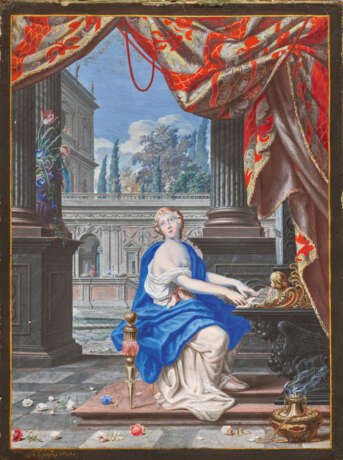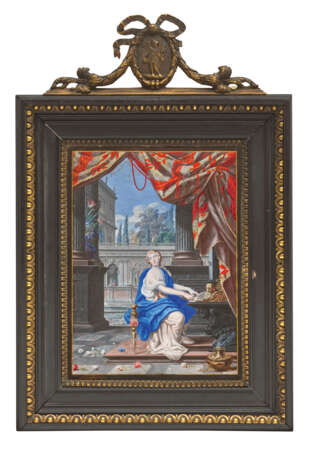ID 922531
Лот 50 | THOMAS LEFEBURE (BRUXELLES 1636-1720 DURLACH)
Оценочная стоимость
€ 15 000 – 25 000
Sainte Cécile jouant de l’orgue
signé et daté ‘T. lefebure. 1676.’ (en bas à gauche)
gouache rehaussé d'or sur parchemin, placé sur plaque de cuivre
15,8 x 11,8 cm (6 1/4 x 4 5/8 in.)
Provenance
Frédéric VI (1617-1677), margrave de Bade-Durlach (1659-1677), Durlach, château de Karlsburg; par descendance à son fils,
Frédéric VII Magnus (1647-1709), margrave de Bade-Durlach (1677-1706), transféré à Bâle en 1688 ; puis par descendance jusqu’en 1808; vente, Bâle, 11-16 juillet 1808.
Conrad Cramm (1760-vers 1819), Bâle, en 1812.
Baron Moritz Carl Hugo de Bethmann (1848-1922), Paris ; sa vente, Hôtel Drouot, Paris, 21-22 juin 1923, partie du lot 121.
Raymond Gid (1905-2000), Paris; vente Rossini, Paris, 15 juin 2022, lot 23.
Literature
C. Roth, ‘Der ehemalige Basler Besitz der Markgrafen von Baden’, in Basler Jahrbuch, 1912, p. 245.
H. Rott, Kunst und Künstler am Baden-Durlacher Hof bis zur Gründung Karlsruhes, Karlsruhe, 1917, p. 133, n. 1.
H. Vey, ‘Die Gemälde der Markgrafen von Baden-Durlach nach den Inventaren von 1688, 1736 und 1773’, in Jahrbuch der Staatlichen Kunstsammlungen in Baden-Württemberg, XXXIX, 2002, p. 26, no. 6 (‘Eine Sancta Cecilia, von Le Febure gemalt (1808 versteigert)’), et 40, no. 93 (‘Eine Sancta Caecilia, auf dem Klavier spielend, en miniature, von Le Febure (1808 versteigert; datiert 1676)’).
Post lot text
THOMAS LEFEBURE, SAINT CECILIA PLAYING ORGAN, BODYCOLOUR HEIGHTENED WITH GOLD ON VELLUM, PLACED ON A COPPER PLATE, SIGNED AND DATED 1675
This exquisite miniature is an important addition to the work of a rare artist, not only for its quality and condition, but also for its prestigious provenance, here detailed for the first time. Next to nothing is known about its maker’s artistic education. Born in Brussels, Lefebure must have come early on in contact with Joseph Werner, the great Swiss miniaturist early on (for Lefebure, see H. Rott, op. cit., pp. 131-134, 142-143, 150, 153, 159; U. Thieme and F. Becker, Allgemeines Lexikon der bildenden Künstler von der Antike bis zur Gegenwart, XXI, Leipzig, 1928, p. 558; and L.R. Schidlof, La Miniature en Europe aux 16e, 17e, 18e et 19e siècles, Graz, 1964, I, pp. 493-494; for Werner, see J. Glaesemer, Joseph Werner, 1637-1710, Zurich and Munich, 1974). Their encounter may have taken place in Paris or Versailles, where Werner was active for Louis XIV from 1662 until 1667. What may be Lefebure’s earliest known work, an allegorical portrait of Louis XIV and Mademoiselle de La Vallière, is dated 1670 (sale Palais des Congrès, Versailles, 5 March 1978, lot 19, as François Lefebure). However, by the time he made this work, he seems to have already moved East, where he was appointed ‘peintre en mignature’ of the Margrave of Baden-Baden, William (r. 1621-1677), later entering the service of the House of Baden-Durlach. He travelled to Venice to study architecture in 1674, and after his return in 1688 was appointed court architect by Margrave Fredrick VII Magnus (r. 1677-1709). (It can be noted here that Werner, too, had connections to the margraves: in 1677, he etched an allegorical portrait on the occasion of the death of Frederick VI, Fredrick Magnus’s predecessor (Glaesemer, op. cit., no. 62, ill.).) Lefebure’s later career was mainly that of an architect, to which architectural designs and some buildings still attest today.
The few miniatures known by Lefebure seem to all date from the 1670s, and include a Vertumnus and Pomona from 1674 (with Galerie Eric Coatalem, 2000), park scenes, one with lovers, from 1675 and 1677 (sale Beaussant et Lefèvre, Paris, 17 June 2005, lot 11), another Vertumnus and Pomona from 1676 (The Metropolitan Museum of Art, inv. 33.136.13; see G. Reynolds, with K. Baetjer, European Miniatures in the Metropolitan Museum of Art, New York, 1997, no. 21, ill.), and a portrait of a young boy from 1678 in the Frits Lugt Collection, Paris, inv. 8428 (K. Schaffers, Portrait Miniatures in the Frits Lugt Collection, Paris, 2018, I, no. 97, II, ill.). They reveal his sophisticated technique, which Graham Reynolds (in connection with the aforementioned work in New York) called ‘surprisingly distinguished’, and which he noted was ‘exceptional in displaying his interest in architecture’ (Reynolds, op. cit., p. 78). This is even more true for the present work, where the patron saint of musicians plays a monumental chamber organ in the splendour of a hall in classical style against the backdrop of a palace wall and garden. Lefebure’s virtuoso brush not only excels in the depiction of the buildings, but also in the flowers in the vase at left and strewn over the hall’s marble floor, the censer at lower right and the heavy brocade curtain, pulled up to reveal the scene.
Lefebure may have drawn inspiration from a similar depiction of the Roman virgin martyr by Werner from the 1660s (with Galerie Didier Aaron, Paris, in 2015). Miniatures by both Lefebure and Werner appear together in the inventories from 1688/1693 and 1736/1773 of the collections of the Margraves of Baden-Durlach in Basel, where they had a summer palace. Apart from the present work, Lefebure was represented by three other miniatures, depicting Herodias with the head of Saint John the Baptist, a landscape in which Cupido carves a bow, and an Italianate landscape with three donkeys (Vey, op. cit., pp. 26-27, nos. 8, 25, 62, pp. 40-41, nos. 91, 99, 101). Among a number of works by Werner was a miniature painting depicting ‘the history of Alexander the Great, giving his mistress [Campaspe] to Apelles’ (Vey, op. cit., p. 26, no. 1, p. 40, no. 86). Both the miniature by Werner and Lefebure’s work under discussion were sold at auction in 1808 by the city of Basel after it had become the owner of the summer palace of the Margraves (ibid., pp. 12, 14-16); and shortly after he sale, its organiser, the painter Conrad Cramm, acquired them, and they stayed together until the sale of the collection of the French poster artist Raymond Gid in 2022 (see provenance; Werner’s miniature, here reproduced in fig. 1, was offered under lot 22). Both identically and lavishly framed in the nineteenth century, probably by its then-owner, the collector Baron Hugo de Bethmann, the works attest to the outstanding talents of two closely related artists. That of Werner has already enjoyed the attention of collectors and scholars for some time; that of Lefebure deserves to be rediscovered.
Fig. 1. Joseph Werner, Alexandre the Great offering his mistress Campaspe to the painter Apelles. Benjamin Peronnet Fine Art, Paris.
| Художественный стиль: | Старые мастера |
|---|---|
| Место происхождения: | Бельгия, Западная Европа, Европа |
| Категория аукционного дома: | Все остальные типы объектов, Рисунки |
| Художественный стиль: | Старые мастера |
|---|---|
| Место происхождения: | Бельгия, Западная Европа, Европа |
| Категория аукционного дома: | Все остальные типы объектов, Рисунки |
| Адрес торгов |
CHRISTIE'S 9 Avenue Matignon 75008 Paris Франция | ||||||||||||||
|---|---|---|---|---|---|---|---|---|---|---|---|---|---|---|---|
| Предосмотр |
| ||||||||||||||
| Телефон | +33 (0)1 40 76 85 85 | ||||||||||||||
| Факс | +33 (0)1 40 76 85 86 | ||||||||||||||
| Условия использования | Условия использования | ||||||||||||||
| Транспортировка |
Почтовая служба Курьерская служба Самовывоз | ||||||||||||||
| Способы оплаты |
Банковский перевод | ||||||||||||||
| Часы работы | Часы работы
|





